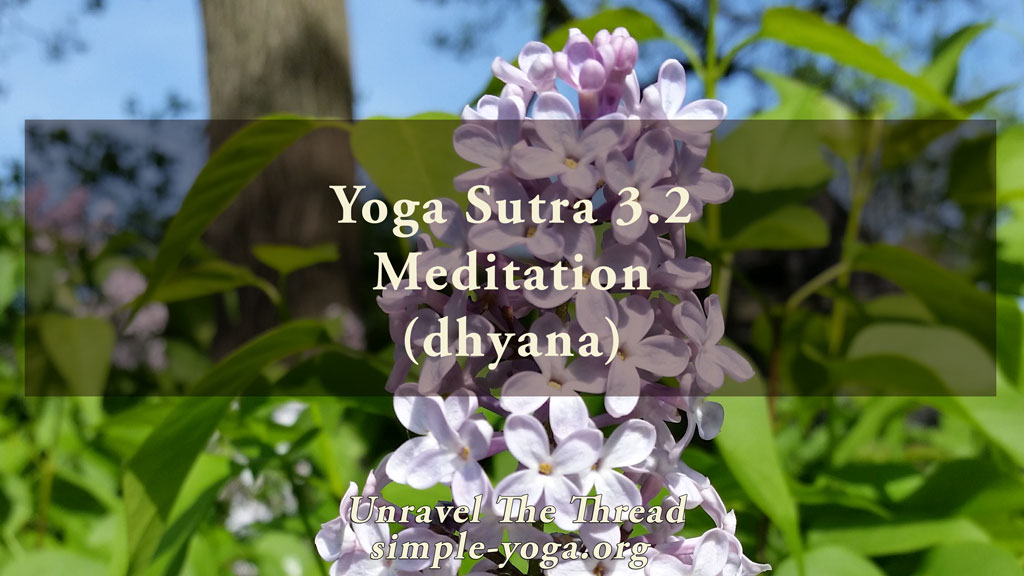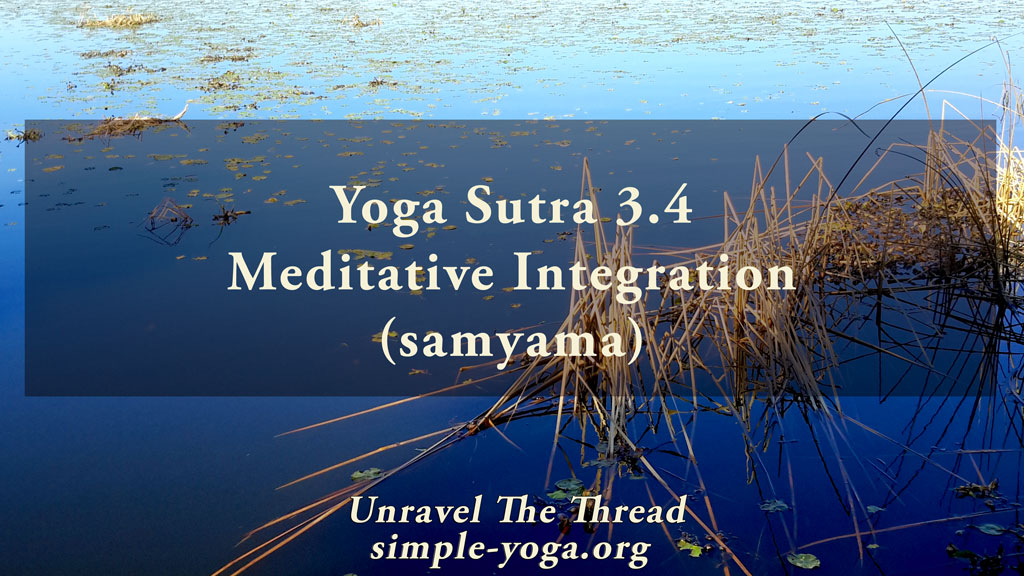
3.2 Meditation – dhyana
May 30, 2021
3.4 Meditative integration – samyama
June 12, 2021
3.2 Meditation – dhyana
May 30, 2021
3.4 Meditative integration – samyama
June 12, 20213.3 Samadhi – integration

3.3 Samadhi is the ensuing dynamic integration empty of separateness.
In the Sanskrit language some of the meanings of the word sama include even, level, equable, complete, and whole. Dhi means to hold, to possess. Samadhi can be defined as becoming a receptacle for wholeness or possessing equanimity and fullness. The journey through the preceding seven steps leads incrementally into a state characterized by the release of any remaining attachment to your preferences, likes, dislikes, and objections that results in being with what is as it is. Samadhi is the result of the dynamic process of letting go of everything that generates the idea of being separate, alone, and disconnected. Growing evidence from research on meditation seems to confirm what Patañjali is saying about removal of separateness. Brain activity of consistent meditators shows a reduction of activity in areas of the brain involved in self-centeredness and rumination (Wolkin) as well as an increase in positive emotions like generosity, compassion, and loving kindness (Lutz, Brefczynski-Lewis and Johnstone) . In the yoga tradition, this is the process initiated by practicing the yamas to create harmony in one’s life and complemented by the niyamas to establish internal harmony.
As you grow in your ability to focus, it becomes apparent that most of what you consider you and your life consists of changing phenomena, your body, your thoughts, your memories, and your preferences. Consequently, your attachment to your ideas about who you are or should be weakens because it no longer makes sense to try to “hold yourself together.” As a result, the practice of letting go of the illusion of control (ishvara pranidhana 1.23, 2.1, 2.45) grows organically. It is not surprising that Patañjali says in aphorism 2.45 that being established in humility brings about samadhi. The ability to let go of the filters used to process all perceptions creates the possibility of experiencing life as it is, without having to pass everything through the filter of “I.” This has tremendous implications because it compels you to experience directly the deep interconnectedness between you, your life and all of life as it is manifesting everywhere.
As you recognize your connection to all of life, it becomes more evident that your participation is needed and that it has effects on whatever is happening. The effectiveness and efficiency of your participation depends on the clarity of your intentions, which are predicated on your internal harmony. Thus, rather than seeing ishvara pranidhana, releasing the illusion of control, as a way to abdicate your agency, you recognize that it is important and necessary for you to participate in life with enthusiasm, wisdom and humility (2.1). In other words, instead of choosing to give up and to isolate yourself, you decide to contribute to enhance the expression of life in the best ways available to you. Remember, do not allow other people to make choices for you. Instead, choose to act from your internal harmony and from the direct experience of deep interconnectedness with all that exists.
The deep integration of samadhi is not a static state but a dynamic and wholehearted participation in the endless interaction between life and awareness. Integration (samadhi) is the result of articulating all your internal aspects at the physical, physiological, mental, and emotional levels by dropping obstacles, restrictions, inefficiencies, and all misidentifications. The complementary integration contributing to samadhi is the effortless articulation between you and the rest of you, the world that you are embedded in. By freeing yourself from the ideas and preferences that generate and perpetuate the notion of being disconnected from yourself, from other people, from the environment and from all of life, you create the necessary mental and emotional space to recognize that you have never been isolated. Similarly, you realize that you are the locus where life is manifesting in ever changing, unique, unrepeatable, and unpredictable ways. Therefore, the Yoga Sutra reminds you that the greatest obstacle is to forget your true nature (avidya 2.4 & 2.17), because you end up confusing who you think you are with who you actually are, the direct ineffable experience of life and embodied awareness in a unique manifestation, you. The desire to become evinces this fundamental misidentification.
Samadhi is integration understood as a symbiotic, synergistic, and comprehensive articulation between inside and outside. Samadhi cannot be forced into happening. It blossoms by removing the obstacles along the way.
Is it possible for you to notice your own interpretive frames and to be able to regulate them?
Is your experience different when you choose to witness life instead of trying to control it?
Can your distractions reveal the obstacles that need to be removed?
Is the desire to become one of these obstacles?
Can you shift from reactivity to responsiveness by releasing attachment to identity and outcomes?
What contributes to deepening your inner silence and stillness?
Is it possible to let go of your individual identity during your meditation?
Is the ground of your experience separateness or connectedness?
What is the difference between the two?
Which one feels better for you?
Does one feel more like you are coming home?
As usual, one more way of exploring the meaning of this sutra is by chanting it.
You can choose to chant it in its traditional form with some of the words coming together:
3.3 tadevārthamātranirbhāsaṃ svarūpaśūnyamivasamādhiḥ
तदेवार्थमात्रनिर्भासं स्वरूपशून्यमिवसमाधिः ॥३॥
Another option is to chant each word in the sutra individually:
- tat
- eva
- artha
- mātra
- nirbhāsaṃ
- svarūpa
- śūnyam
- iva
- samādhiḥ
If you prefer, you may listen to the podcast:
Unravel the thread is now available as a book!
If you find Simple-Yoga.org and Unravel the thread useful, consider supporting my labor with a donation, you may also donate using PayPal or Venmo. Thank you!
